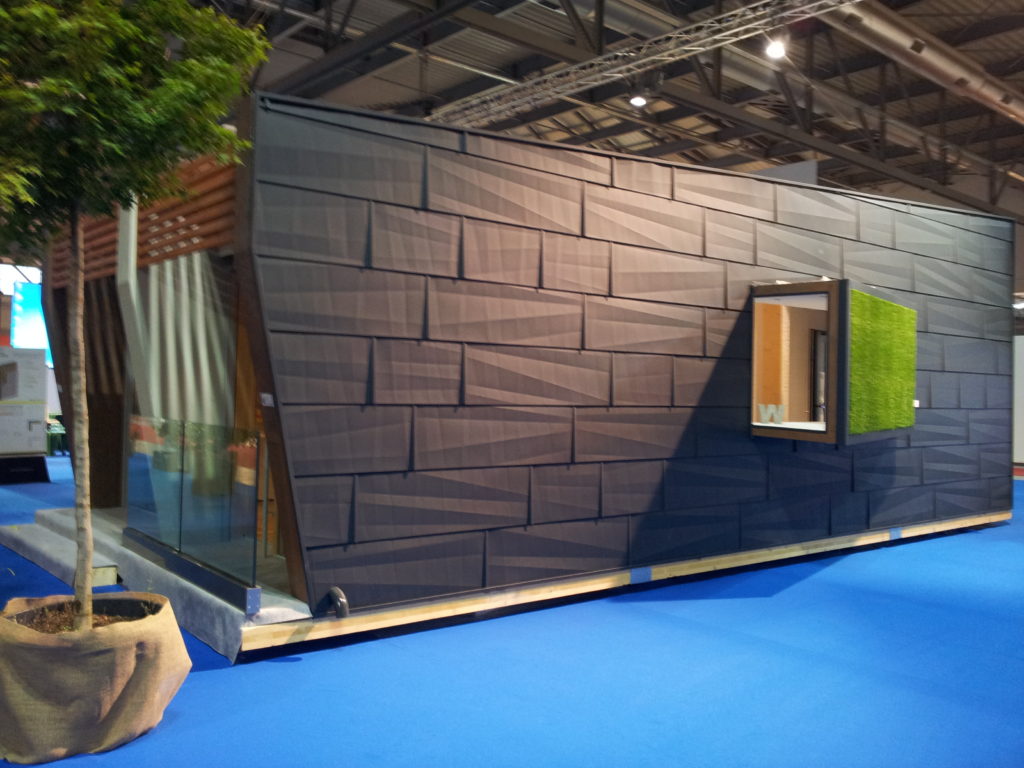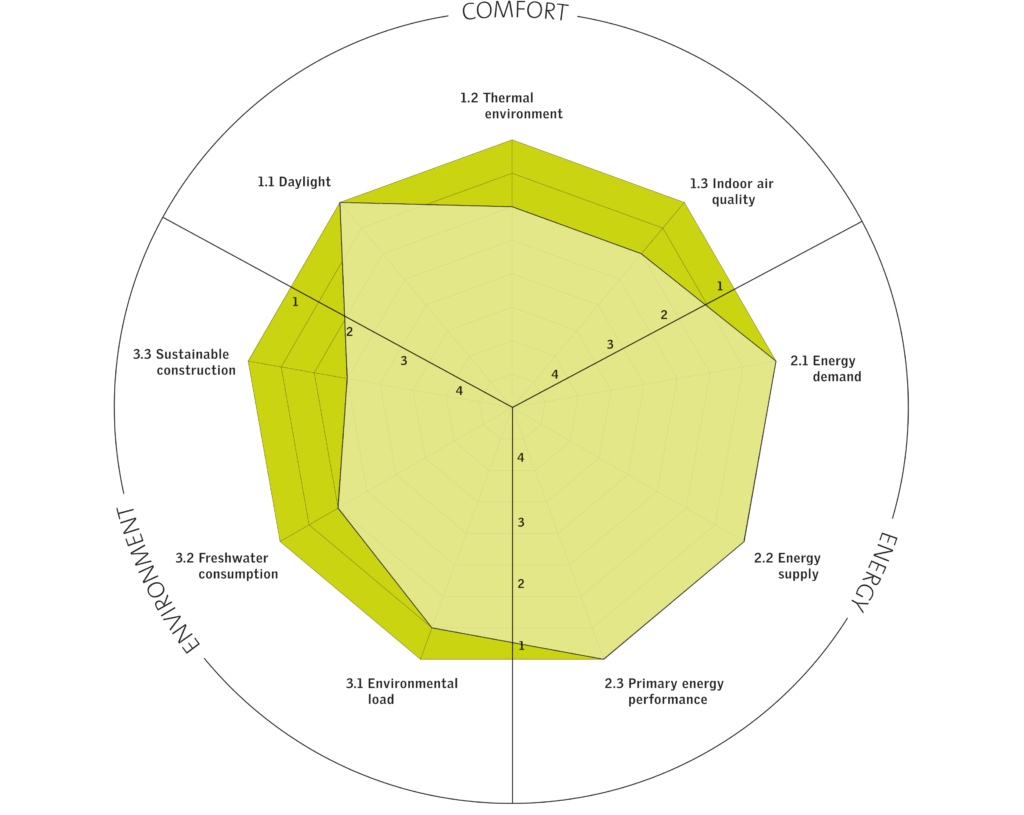LIVINGBOX
All constructive solutions combined with the architectonic choices have been studied to reduce the environment impact trough the best exploitation of the free contributions offered from the surroundings in terms of solar and wind contributions to produce clean energy. The roof could be a “garden roof” to reduce the energy losses and at same time to minimize the heat island effect. It could be integrated with different systems for producing energy from renewable sources, as a solar active system or a small wind turbine, in order to minimize the fossil energy consumption. A PV system can be integrated in the roof. With 16 modules and a surface of 20 m2 it is possible to produce 4400 KWp/a. The heating is achieved with heat pump that produces also the sanitary hot water. All these constructive solutions make of Livingbox an Active House that uses the energy produced by itself giving the extra production to the net or to other users. The total energy demand of the house, calculated with Design Builder software, is 807,8 kWh/a, articulated in 260.00 kWh/a for the lighting, 287,1 kWh/a for the heating and 260.8 kWh/year for the sanitary hot water. The positive balance is 1637 kWh/a of extra production. The consumption index for the different typologies are: lighting 6,42 kWh/(m2x a), heating 7,09 kWh/(m2x a), DHW 6,44 kWh/(m2x a). The Calculation have been developed simulating the building in Rome (Italy), lat. 41°54’39″24 North, long. 12°28’54″48 East. The employed materials such as the paints are low-emissivity. An example in this direction is the water paint with acetic acid for aging the larch of the interior fittings or of the battens wooden finishing of the outer walls.
LIVINGBOX is equipped with a modular home automation system to optimize the relationship between comfort and energy consumption. This allows to manage with integrated modular packages the lighting and the heating, the daylighting, the shading and the natural ventilation. The scenarios are customizable for the different users and they can be activated from remote. In this way when the user will come home he will have the best inner environmental conditions. At same time the user can manage manually the different functions.
The constructive solutions have been designed to minimize the building impact on the environmental matrixes: water, air, soil. The used materials are natural, recyclable or recycled. The extensive use of wood reduces CO2 emission in the atmosphere. The wood used embodies around 9.5 tons of CO2 giving a positive contribution to reduction the greenhouse effect. Even the other used materials, mostly recycled, were chosen through a Life Cycle Assessment (LCA) including the aspects that minimize the CO2 emitted in the atmosphere during the construction, maintenance and disposal (Figure 6). The used software for the LCA is “SimaPro2 and Ecoinvent is the used database. For several product was used the Environmental Product Declaration (EPD).
DESCRIPTION:
The habitative unit is built joining two precast industrialized basic modules. One is specialized and equipped with the bathroom and the kitchen including pipes, heating pump, tank, heating system, electrical system, control devices panel and touch screen for managing the building automation. The second is free and available for any functional attribution.
The dimensions of a single module are meters 2.49 (width) x 9.99 (length) x 2.99 (height). With these dimensions it can be transported, for the Italian code of the road traffic, with a truck trailer without being classified as a “special cargo”. It can also be transported by railway wagons to minimize the CO2 emission.The living unit is articulated in a fixed block kitchen-bath and in a large multi-purpose space that can be articulated during the day. The unit can be expanded from 40.50 to 60.80 m2 net. In this last case the kitchen and the bathroom block are bigger. The units can be put together for generating terraced houses or block houses up to three storey. The living unit can be organized functionally also in different way. One example could be the solution as hotel. In this case the space is articulated in a room of about 15.00 m2, in a multi-functional space between the bedroom and the bathroom access, about 5.00 m2, equipped with a wardrobe (length 2.40 m), and a bathroom, about 5.00 m2. The units aggregation can generate different types of buildings: terraced hous, blocks up three storey or small settlements with the units spread over the territory.
For its typological flexibility Livingbox could be structured as part of different building, maintaining the base concept of the transportability and the modularity. It is possible to redesign the inner space realizing different typological solutions. As example it could think Livingbox as a core units of open air restaurant, coffee shop, etc..
The unit can be customized from different points of view: constructive, technological and furnishings.The layout of the Livingbox walls and floors has been thought to follow the user needs for what concern the inner comfort. It means that it is possible to modify the layouts of the walls maintaining the same wooden panels. As example there is the possibility to maintain the insulation material modifying the thickness or changing totally the material. Significant, for what concern the last one situation, is the possibility to have the external finishing as ventilated wall, or plastered. To use rock wool instead sheep wool for insulation. This last choice, as example, could be related to the request fire resistance of the wall. In other cases economic evaluations could be the base of the different choices. The cost of the unit can be higher or lower depending for the different solutions starting from the basic solution able to ensure the right comfort.
Several solutions have been thought to customize the unit improving the basic version, maintaining always the “concept” without modification to the basic structural solution. For what concern the heating an heat pump (COP=3.8), eventually powered by photovoltaic system (PV), is the base of the heating ventilation system (HV) and the production of sanitary hot water (SHW). At same time the PV system produces electricity for the artificial lighting and for all electrical devices. The water for sanitary use could be harvests from an integrated filtering system connected with the roof garden. Other step towards the customization is the introduction of the building automation to manage the different scenarios for the entertainment and for saving energy managing the daylighting, the heating and the natural ventilation. Equipped with the building automation and realized with sustainable solutions the modular unit is a “smart home”. In this case it could be connect to other similar unit equipped with analogous system for sharing information and energy and/or with the public net as part a smart district.
From a constructive point of view the main characteristic of Living Box is that it is built with load-bearing massive panels: Cross Laminated Panels (XLam). The constructive Xlam solution consists in building a load-bearing panel using three or more layers of boards. Each layer is orthogonal to the previous for offsetting the deformation or the movement of the boards. These last one are connected by glue, aluminum nails or beech pegs. The connections between the panels are with screws, steel corner plates and “hold-down”. In this way it is possible to build a box with good characteristics as earthquake resistant, free to be finished with different solutions for each kind of customization in terms of energy efficiency, aesthetic solutions or economic choices.




